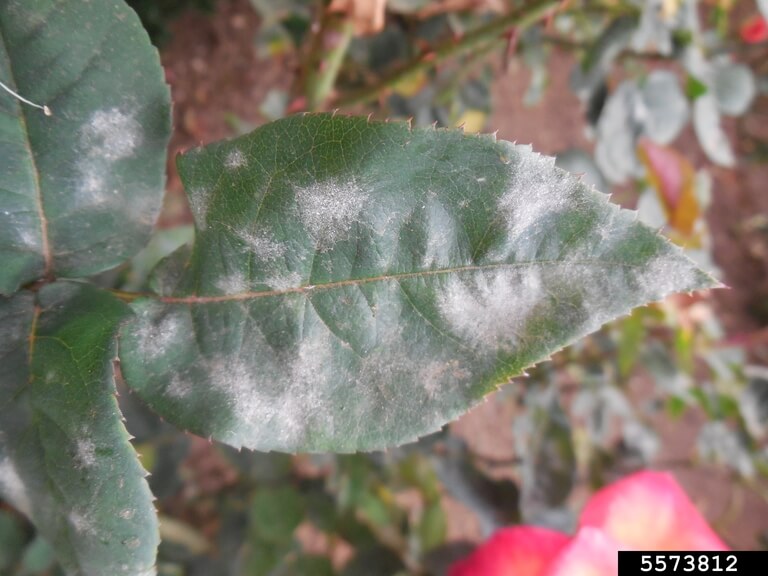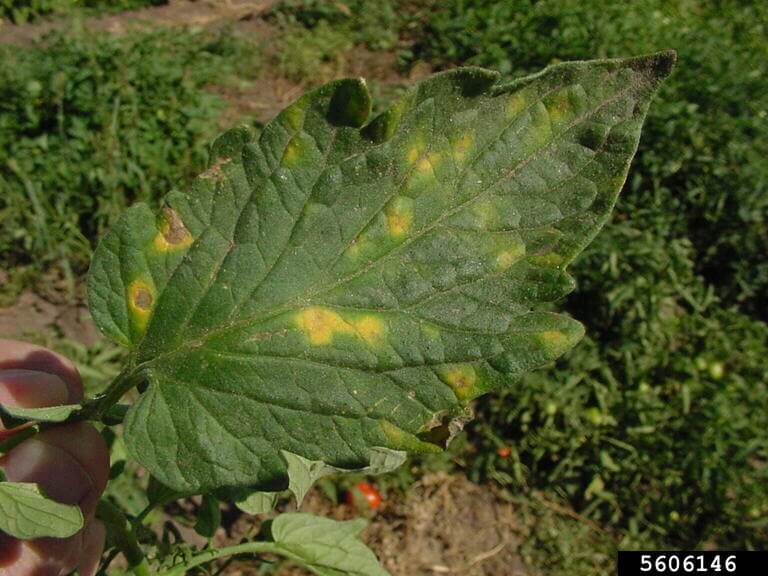
Powdery mildew on roses and squash looks like flour or talcum powder. Dr Parthasarathy Seethapathy, Amrita School of Agricultural Sciences, Amrita Vishwa Vidyapeetham, Bugwood.org.
Have you seen powdery mildew on your plants? This is the time of year when conditions are ideal for this fungal disease. Powdery mildew is common on a wide range of plants, including annuals, perennials, food crops such as squash and pumpkins, and ornamental shrubs such as roses, hydrangeas, rhododendrons, some azaleas, nandina and crape myrtle. The University of California Integrated Pest Management Program has a list of common ornamentals that are susceptible to powdery mildew.
Common Ornamentals Susceptible to Powdery Mildew
| aster | crape myrtle | oak |
| azalea (deciduous) | dahlia | pansy |
| begonia (tuberous) | delphinium | phlox |
| calendula | euonymus | ranunculus |
| California poppy | forget-me-not | rose |
| China aster (Calistephus) | gaillardia | rhododendron |
| chrysanthemum | hydrangea | rudbeckia |
| Clarkia | lilac | snapdragons |
| columbine | London plane tree | sweet pea |
| coral bells (Heuchera) | lupine | verbena |
| corn flower | mint | vinca |
| cosmos | monarda | zinnia |

Powdery mildew on tomatoes and rhododendrons looks like yellow, purple or brown spots. Gerald Holmes, Strawberry Center, Cal Poly San Luis Obispo, Bugwood.org.
Powdery mildew does best when damp nights are followed by warm, sunny days, such as in late summer and fall. There are many different species of powdery mildew, and each species only attacks plants in a specific family.
How to identify
- Plants such as squash, pumpkins and roses: look for white spots on the leaves. The leaves look like they’ve been dusted with flour or talcum powder. The spots gradually spread over wide areas of the leaves and stems.
- Plants such as tomatoes, artichokes and rhododendrons: look for yellow, purple or brown spots.
What you can do
Here are tips for managing powdery mildew, from prevention to cultural practices to treatment.
Prevention
The best method of control is prevention. The first step is to choose disease-resistant plants or varieties. Many plants have cultivars bred to resist powdery mildew.
The American Rhododendron Society has lists of resistant varieties, localized to western Washington areas.
Here is a list of resistant ornamentals from the University of California Statewide Integrated Pest Management Program.
| Susceptible Plant | Resistant Cultivars |
|---|---|
| crape myrtle | those with Native American names, e.g., ‘Catawba,’ ‘Cherokee,’ ‘Hopi’ |
| euonymus | variegated varieties more resistant than nonvariegated types |
| London plane tree | ‘Yarwood,’ ‘Columbia,’ ‘Liberty’ |
| monarda | ‘Marshall’s Delight,’ ‘Blaustrumph,’ ‘Colrain Red’ |
| phlox | Phlox maculata ‘Natasha,’ P. glaberrima ‘MorrisBerd,’ P. paniculata ‘Robert Poore,’ ‘David’ |
| rose | ‘Simplicity’ and ‘Meidiland’ roses, Rosa rugosa varieties |
| rhododendron | R. yakushimanum, R. macrophyllum, R. ‘Nova Zembla,’ R. ‘Palestrina’ |
| zinnia | Pulcino and African zinnias |
Cultural practices
- Give your plants space and a sunny site. Powdery mildew thrives where plants are crowded and there isn’t enough air circulation.
- Don’t over-fertilize.
- Be careful about where your plants are situated. Plants that are next to the house may get powdery mildew even if they are not prone to the disease.
- Choosing the right watering practices can be challenging. Both overwatering and under watering may lead to powdery mildew.
- Water in the morning so plants can dry out, reducing the potential for infection by other fungal diseases, such as rust or black spot.
- Overhead watering may actually reduce the spread of powdery mildew in the short term because it washes spores off the plant. It does, however, make the plants more damp, which encourages powdery mildew spores to develop.
- Pruning can help. Prune out dense growth to help increase air circulation. Prune out severely affected leaves when symptoms are present.
Treatment
Begin monitoring for powdery mildew symptoms in mid-summer. Call us if you are concerned.
Sometimes a fungicide may be needed. There are several less-toxic fungicides available, including horticultural oils, neem oil, jojoba oil, sulfur and the biological fungicide Serenade.
With the exception of the oils, these work best when applied to susceptible plants before symptoms appear or in the earliest stages of the disease. They only work on contact, so be sure to cover all parts of the plant. You may need to apply again, every seven to 10 days, as the plant grows.
If mild to moderate powdery mildew is present, you can use horticultural and plant-based oils such as neem or jojoba oil. Oils are most useful in eradicating, rather than preventing, the disease.
According to University of Washington Botanic Gardens, “Some sources (such as The Organic Gardener’s Handbook of Natural Insect and Disease Control, edited by Barbara Ellis, Rodale Press, 1996) suggest that a baking soda spray (1 tsp. per 1 quart of warm water, with a bit of dish soap) is protective or preventive, but Washington State University Extension professor Linda Chalker Scott disputes the efficacy of this method. She says that other methods work better:
‘Other treatments have been more successful in powdery mildew control, including horticultural oils, potassium bicarbonate, potassium phosphate, sulfur, milk, and even
water sprays. Probably the most field success has been found in combining SBC [sodium bicarbonate] with horticultural oils, including mineral and vegetable oils (see the Fall 2008 MasterGardener magazine). The mixtures are so effective that they’ve been successful even on serious powdery mildew epidemics.’”

Big leaf maples were showing heavy mildew on the I-5 overpass on 230th St in Mountlake Terrace. What was interesting is that it was bad on one side of the road but not the other side. Shouldn’t do much damage to those trees. Azaleas (mollis and occidentatlis types) and Nandina are also heavily hit as a rule.
Thanks for the info, Sharon.I appreciate it. I will add azaleas and nankin to the list.